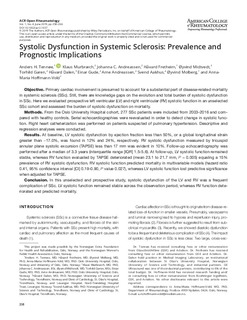| dc.contributor.author | Tennøe, Anders H | |
| dc.contributor.author | Murbraech, Klaus | |
| dc.contributor.author | Andreassen, Johanna | |
| dc.contributor.author | Fretheim, Håvard Halland | |
| dc.contributor.author | Midtvedt, Øyvind | |
| dc.contributor.author | Garen, Torhild Oddveig | |
| dc.contributor.author | Dalen, Håvard | |
| dc.contributor.author | Gude, Einar | |
| dc.contributor.author | Andreassen, Arne K. | |
| dc.contributor.author | Aakhus, Svend | |
| dc.contributor.author | Molberg, Øyvind | |
| dc.contributor.author | Hoffmann-Vold, Anna-Maria | |
| dc.date.accessioned | 2020-02-07T11:57:11Z | |
| dc.date.available | 2020-02-07T11:57:11Z | |
| dc.date.created | 2019-12-06T22:16:34Z | |
| dc.date.issued | 2019 | |
| dc.identifier.citation | ACR Open Rheumatology. 2019, 1 (4), 258-266. | nb_NO |
| dc.identifier.issn | 2578-5745 | |
| dc.identifier.uri | http://hdl.handle.net/11250/2640397 | |
| dc.description.abstract | Objective
Primary cardiac involvement is presumed to account for a substantial part of disease‐related mortality in systemic sclerosis (SSc). Still, there are knowledge gaps on the evolution and total burden of systolic dysfunction in SSc. Here we evaluated prospective left ventricular (LV) and right ventricular (RV) systolic function in an unselected SSc cohort and assessed the burden of systolic dysfunction on mortality.
Methods
From the Oslo University Hospital cohort, 277 SSc patients were included from 2003‐2016 and compared with healthy controls. Serial echocardiographies were reevaluated in order to detect change in systolic function. Right heart catheterization was performed on patients suspected of pulmonary hypertension. Descriptive and regression analyses were conducted.
Results
At baseline, LV systolic dysfunction by ejection fraction less than 50%, or a global longitudinal strain greater than −17.0%, was found in 12% and 24%, respectively. RV systolic dysfunction measured by tricuspid annular plane systolic excursion (TAPSE) less than 17 mm was evident in 10%. Follow‐up echocardiography was performed after a median of 3.3 years (interquartile range [IQR] 1.5‐5.6). At follow‐up, LV systolic function remained stable, whereas RV function evaluated by TAPSE deteriorated (mean 23.1 to 21.7 mm, P = 0.005) equaling a 15% prevalence of RV systolic dysfunction. RV systolic function predicted mortality in multivariable models (hazard ratio 0.41, 95% confidence interval [CI] 0.19‐0.90, P value 0.027), whereas LV systolic function lost predictive significance when adjusted for TAPSE.
Conclusion
In this unselected and prospective study, systolic dysfunction of the LV and RV was a frequent complication of SSc. LV systolic function remained stable across the observation period, whereas RV function deteriorated and predicted mortality. | nb_NO |
| dc.language.iso | eng | nb_NO |
| dc.publisher | Wiley Periodicals, Inc. on behalf of American College of Rheumatology. | nb_NO |
| dc.rights | Navngivelse-Ikkekommersiell 4.0 Internasjonal | * |
| dc.rights.uri | http://creativecommons.org/licenses/by-nc/4.0/deed.no | * |
| dc.title | Systolic dysfunction in systemic sclerosis: Prevalence and prognostic implications | nb_NO |
| dc.type | Journal article | nb_NO |
| dc.description.version | publishedVersion | nb_NO |
| dc.source.pagenumber | 258-266 | nb_NO |
| dc.source.volume | 1 | nb_NO |
| dc.source.journal | ACR Open Rheumatology | nb_NO |
| dc.source.issue | 4 | nb_NO |
| dc.identifier.doi | 10.1002/acr2.1037 | |
| dc.identifier.cristin | 1757804 | |
| dc.description.localcode | This is an open access article under the terms of the Creative Commons Attribution‐NonCommercial License, which permits use, distribution and reproduction in any medium, provided the original work is properly cited and is not used for commercial purposes. | nb_NO |
| cristin.unitcode | 194,65,25,0 | |
| cristin.unitname | Institutt for sirkulasjon og bildediagnostikk | |
| cristin.ispublished | true | |
| cristin.fulltext | original | |

